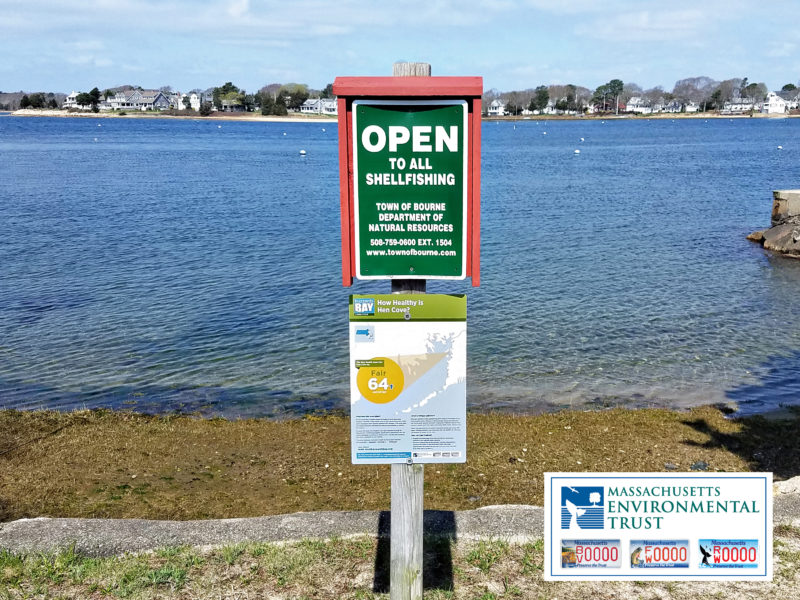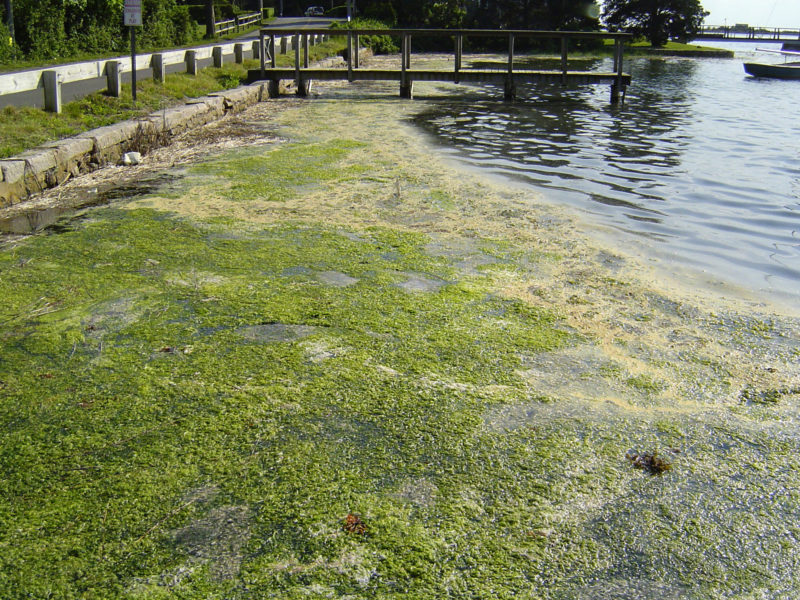Buzzards Bay health continuing to improve, as actions to protect clean water multiply
Bold actions to protect clean water are making a difference to Save Buzzards Bay. That’s what we saw on the Bay in the summer of 2018, according to Bay Health data collected through our Baywatchers monitoring program. Last summer’s conditions continued an upward trend of clearer, healthier waters across the Bay.

While you’re out enjoying the water this summer, look out for 142 new Bay Health signs installed at piers, beaches, and boat launches all around Buzzards Bay. These signs display Bay Health scores for the waterways where they are located. These signs were made possible with funding from the Massachusetts Environmental Trust.
Over the past five years, the Bay’s health has largely improved in most places. Roughly two-thirds of waterways monitored in 2018 showed an improvement compared to the previous year. Only 11 waterways showed declining health, and 20 places remained unchanged.
The Coalition uses information gathered by Baywatchers to produce the Bay Health Index, which scores the health of harbors, coves, and rivers from 0 to 100. You’ll see these scores out on the Bay this summer, posted on new Bay Health signs at piers, beaches, and boat launches all around the region. To find out how your favorite corner of the Bay is doing, visit savebuzzardsbay.org/bayhealth.
Overall, about 45 percent of Buzzards Bay’s waterways are now considered healthy, with “good” Bay Health scores. Another 40 percent of waterways are in “fair” condition. The number of waterways in “poor” health, with too much pollution and unhealthy underwater habitats, has fallen below 15 percent.
“The recent data are an encouraging sign that reducing nitrogen pollution will continue to improve water quality,” said Rachel Jakuba, the Coalition’s science director. “You’ll notice it when you go to the beach and see clearer waters, more eelgrass, and less algae.”
Nitrogen pollution is the biggest threat facing Buzzards Bay. When water is polluted with nitrogen, it becomes cloudy and murky with algae that harms fish, shellfish, and eelgrass beds. Traditional septic systems and wastewater are the main source of nitrogen pollution to Buzzards Bay. Now, local efforts to upgrade septic systems and connect more homes to sewer are reducing nitrogen pollution to the Bay’s waters.

Nitrogen pollution fuels the growth of algae blooms, like this one seen in West Falmouth Harbor in 2012.
Take places like Wild Harbor River in Falmouth, where about 200 homes were recently connected to the New Silver Beach wastewater treatment system. This neighborhood-scale wastewater facility was designed to remove nitrogen from wastewater. As a result, nitrogen pollution decreased in 2018, and the river’s health has improved to “good” after nearly two decades of middling “fair” scores.
Since 2015, the Coalition has been working to upgrade septic systems on West Falmouth Harbor with nitrogen-reducing technology. These upgrades have been shown to reduce nitrogen by as much as 78%. And we’re continuing to test a new nitrogen-reducing septic system design called a “layer cake” at homes around the region. As homeowners continue to update outdated septic systems and towns connect more communities to sewer, we will continue to see clearer waters and healthy fish and shellfish populations returning.
Another piece of this Bay-wide improvement is the result of federal Clean Air Act regulations passed in the 1990s. These stricter regulations have reduced the amount of airborne nitrogen from fossil fuel-burning power plants over the last 10 years. Baywatchers data from 2018 found lower levels of inorganic nitrogen, which is the type of nitrogen that comes from air pollution.
“While the Clean Air Act was designed to ensure we all have clean air to breathe, it is also benefitting the Bay’s health by reducing nitrogen blowing in the air and landing on our water,” said Jakuba.
Baywatchers volunteers are already back out on the Bay for the summer 2019 season to continue tracking the Bay’s health. These trained volunteers measure temperature, salinity, water clarity, dissolved oxygen, and weather conditions at more than 200 monitoring stations on 30 major harbors, coves, and rivers across Buzzards Bay. Want to join them? Sign up to volunteer this summer!